In this tutorial, you will be guided step-by-step to display weather data from the Meteorologisk institutt integration, which comes built-in with Home Assistant, using the ESPHome framework on the Seeed Studio reTerminal E1001. You will learn how to fetch temperature readings, weather conditions, and forecasts from Home Assistant, and visually present this information directly on the e-paper display of the reTerminal.
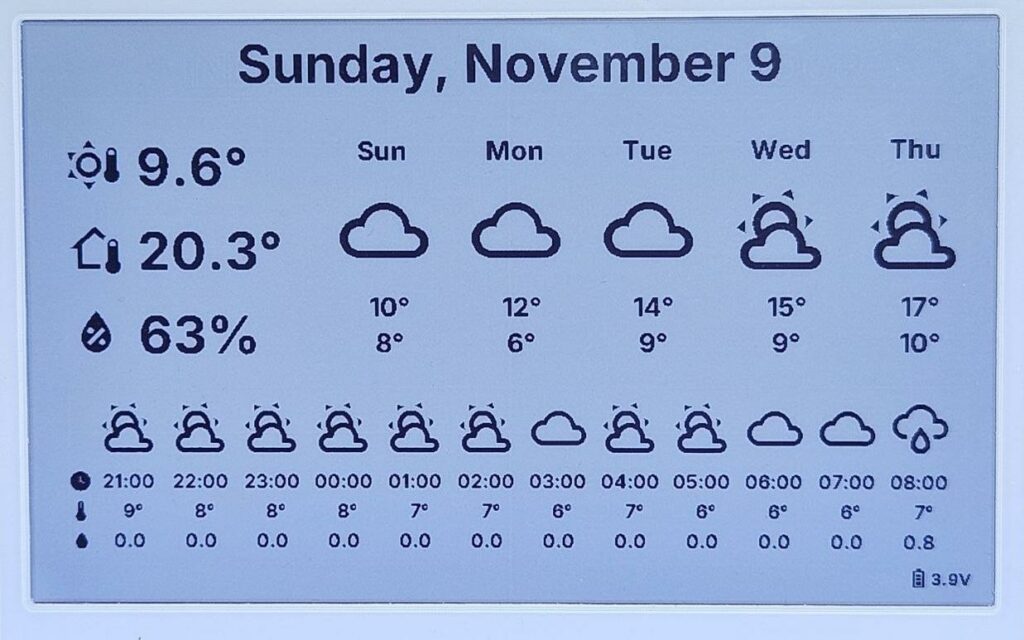
To better understand the configuration of the reTerminal and the display of information from Home Assistant, I recommend reading my previous tutorial “Integrate a reTerminal E1002 into Home Assistant with ESPHome”.
Meteorologisk institutt (Met.no) integration
This weather integration is installed by default on Home Assistant, and provide weather forecast at your location. In its configuration you can select units, and find the entity id that we will use to retreive data: weather.forecast_home.
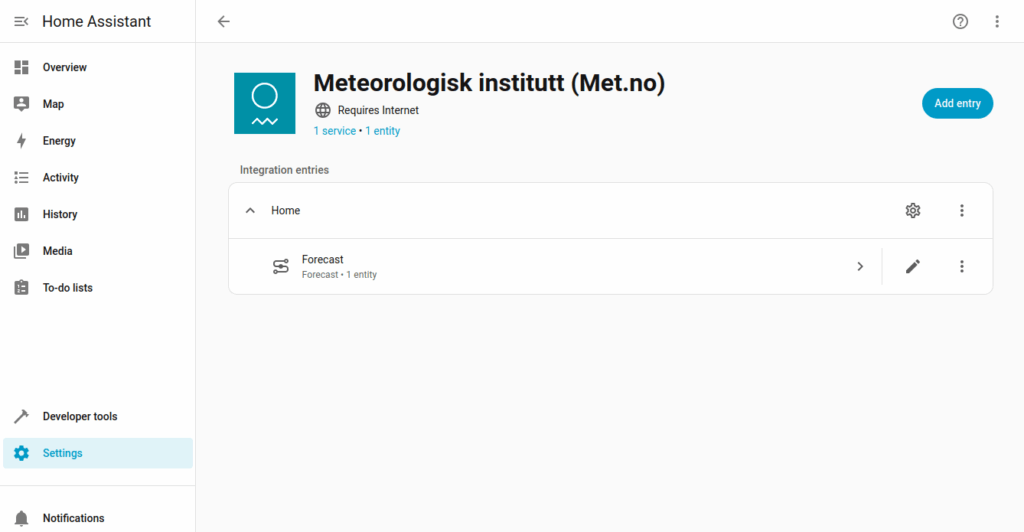
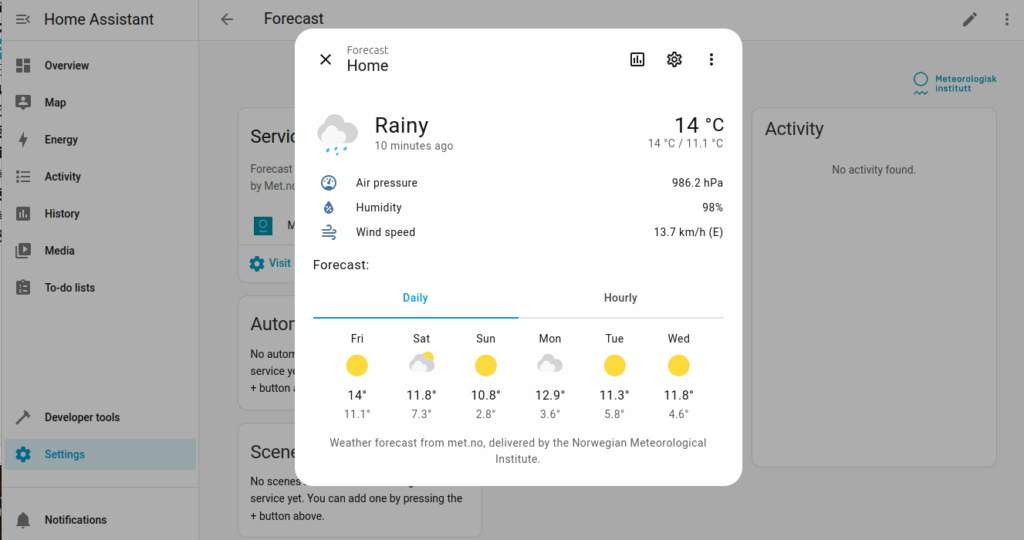
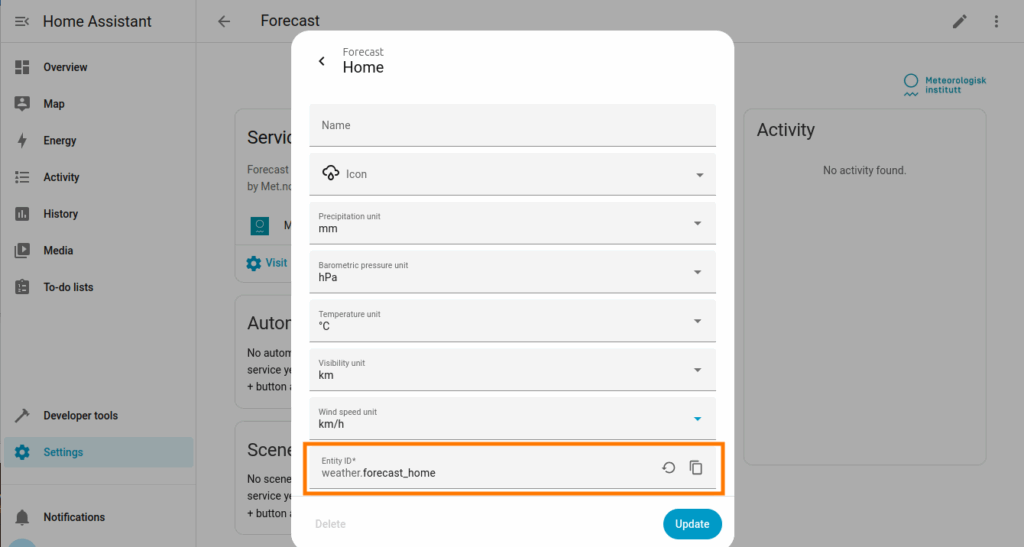
We will first check which information are provided by this integration, using States tab of developer tools. Enter weather as filter, you can see that this entity has weather condition as state (rainy) and several attributes (temperature, dew_point, temperature_unit, humidity…).

As we will see later, we do not see the weather forecast information. Indeed weather forecast are not attributes from weather.forecast_home sensor and must be requested by weather.get_forecasts action on the weather.forecast_home entity.
As we will see later, weather forecast information does not appear because forecasts are not stored as attributes of the weather.forecast_home sensor. To obtain the forecast data, you need to explicitly request it using the weather.get_forecasts action on the weather.forecast_home entity.
Display outdoor temperature
To display the current outdoor temperature, I use the temperature attribute from weather.forecast_home entity_id.
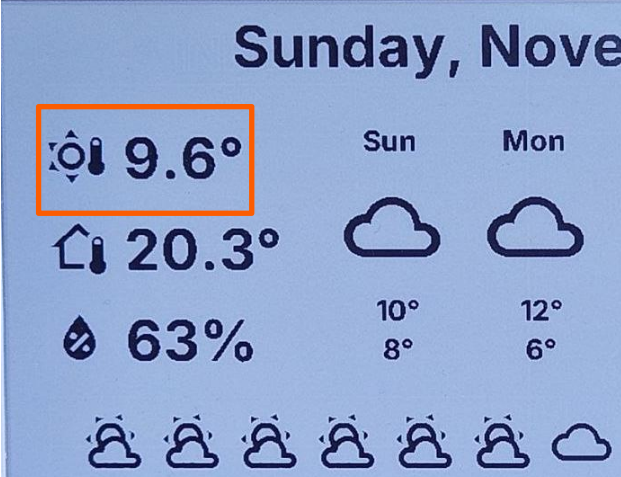
To access weather.forecast_home attributes, you need to create a template sensor “Outdoor temperature” in the Home Assistant configuration file (configuration.yaml).
Modifying this configuration file can be done with help of File Editor add-on. Here is the configuration to add to this file:
To access the attributes of the weather.forecast_home entity, you need to create a template sensor in the Home Assistant configuration file (configuration.yaml). You can edit this configuration file using the File Editor add-on (configuration.yaml) available from the Home Assistant add-ons store.
Below is the configuration snippet to add to your file:
template:
- sensor:
- name: "Outdoor temperature"
unique_id: outdoor_temperature
state: "{{ state_attr('weather.forecast_home','temperature') }}" A corresponding sensor must then be declared in ESPHome configuration file, immediately after the line captive_portal:
sensor:
- platform: homeassistant
id: outdoor_temperature_id
entity_id: sensor.outdoor_temperatureSo temperature can be displayed on the screen of reTerminal :
it.printf(0, 0, id(myFont), "%.1f °C", id(outdoor_temperature_id).state); Display indoor temperature and humidity
To display the indoor temperature and humidity, I use the internal STH40 sensor of the reTerminal.
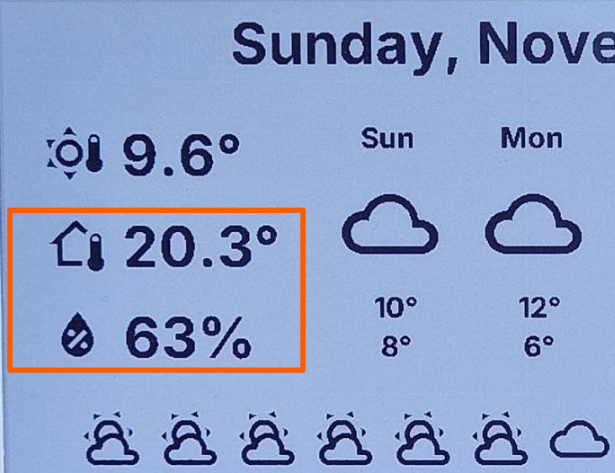
The ESP32-S3 microcontroller in the reTerminal E1001 communicates with the STH40 sensor via an I2C bus. Its I2C address is 0x44, and the I2C bus uses the following pins:
- Serial Data (SDA) : GPIO19
- Serial Clock (SCL) : GPIO20
Here is the YAML configuration that allows you to retrieve the temperature and humidity from this sensor, to be copied immediately after the line captive_portal: in the ESPHome configuration file:
# define I2C interface
i2c:
sda: GPIO19
scl: GPIO20
scan: false
# temperature and humidity sensor
sensor:
# Internal SHT4x temperature/humidity sensor
- platform: sht4x # Sensor platform
id: sht4x_component # ID for the component
temperature: # Temperature sensor
name: "Temperature" # Sensor name
id: sht4x_temperature # ID for temperature sensor
humidity: # Humidity sensor
name: "Humidity" # Sensor name
id: sht4x_humidity # ID for humidity sensor
address: 0x44 # I2C address
update_interval: 60sYou can display the value of this sensor on the reTerminal E1001 screen via the following ESPHome configuration:
it.printf(10, 10, id(myFont), "Temperature: %.1f°C", id(sht4x_temperature).state);
it.printf(10, 40, id(myFont), "Humidity: %.1f%%", id(sht4x_humidity).state); Access to weather forecast data
To access weather forecasts in Home Assistant, you need to execute the weather.get_forecasts action on the weather.forecast_home entity, specifying the type as daily or hourly.
To check if everything is properly configured, you can use the Actions tab of developer tools and enter the following configuration:
action: weather.get_forecasts
entity_id: weather.forecast_home
data:
type: daily
target:
entity_id: weather.forecast_homeYou should get the daily weather forecast for today and the next 5 days in the Response field:

To get hourly weather forecast for the next 48h you can use this configuration:
action: weather.get_forecasts
entity_id: weather.forecast_home
data:
type: hourly
target:
entity_id: weather.forecast_home
Display daily weather forecast
I want to display the daily weather forecast, including the day, condition (icon), maximum and minimum temperature for today and the next four days.

Displaying daily forecasst requires modifying the Home Assistant configuration file (configuration.yaml) to create an automation that executes the weather.get_forecasts action, as well as a custom sensor template to retrieve the weather forecast data.
Here is an example of how to configure daily_weather_forecast_sensor template sensor and its automation, which retrieves the weather forecast (day, min/max temperature and condition) for today and the next 3 days:
template:
- trigger:
- platform: time_pattern
hours: /1
- platform: homeassistant
event: start
action:
- service: weather.get_forecasts
data:
type: daily
target:
entity_id: weather.forecast_home
response_variable: daily_data
sensor:
- name: "Weather forecast"
unique_id: weather_forecast
state: "{{ daily_data['weather.forecast_home'].forecast[0] }}"
attributes:
daily_forecast: "{{ daily_data['weather.forecast_home'].forecast }}"
availability: "{{ states('weather.forecast_home') not in ['unknown', 'unavailable', 'none'] }}"
- sensor:
- name: "Daily weather forecast sensor"
unique_id: daily_weather_forecast_sensor
state: "{{ state_attr('sensor.weather_forecast','daily_forecast')[0] }}"
attributes:
condition0: "{{ state_attr('sensor.weather_forecast','daily_forecast')[0].condition }}"
day0: "{{ as_timestamp(state_attr('sensor.weather_forecast','daily_forecast')[0].datetime) | timestamp_custom('%a', True) }}"
temperature0: "{{ state_attr('sensor.weather_forecast','daily_forecast')[0].temperature | float }}"
templow0: "{{ state_attr('sensor.weather_forecast','daily_forecast')[0].templow | float }}"
condition1: "{{ state_attr('sensor.weather_forecast','daily_forecast')[1].condition }}"
day1: "{{ as_timestamp(state_attr('sensor.weather_forecast','daily_forecast')[1].datetime) | timestamp_custom('%a', True) }}"
temperature1: "{{ state_attr('sensor.weather_forecast','daily_forecast')[1].temperature | float }}"
templow1: "{{ state_attr('sensor.weather_forecast','daily_forecast')[1].templow | float }}"
condition2: "{{ state_attr('sensor.weather_forecast','daily_forecast')[2].condition }}"
day2: "{{ as_timestamp(state_attr('sensor.weather_forecast','daily_forecast')[2].datetime) | timestamp_custom('%a', True) }}"
temperature2: "{{ state_attr('sensor.weather_forecast','daily_forecast')[2].temperature | float }}"
templow2: "{{ state_attr('sensor.weather_forecast','daily_forecast')[2].templow | float }}"
condition3: "{{ state_attr('sensor.weather_forecast','daily_forecast')[3].condition }}"
day3: "{{ as_timestamp(state_attr('sensor.weather_forecast','daily_forecast')[3].datetime) | timestamp_custom('%a', True) }}"
temperature3: "{{ state_attr('sensor.weather_forecast','daily_forecast')[3].temperature | float }}"
templow3: "{{ state_attr('sensor.weather_forecast','daily_forecast')[3].templow | float }}"
condition4: "{{ state_attr('sensor.weather_forecast','daily_forecast')[4].condition }}"
day4: "{{ as_timestamp(state_attr('sensor.weather_forecast','daily_forecast')[4].datetime) | timestamp_custom('%a', True) }}"
temperature4: "{{ state_attr('sensor.weather_forecast','daily_forecast')[4].temperature | float }}"
templow4: "{{ state_attr('sensor.weather_forecast','daily_forecast')[4].templow | float }}" You can check the correct configuration of sensor.daily_weather_forecast_sensor from developper tools:

Note that the day attribute is displayed as abbreviated weekday name thanks to %a argument in timestamp_custom() function. See the Time component documention for details.
Once the sensors are configured in Home Assistant, they must be declared in the ESPHome configuration. Because day and condition are provided as text (for example, “Monday”, “sunny”), they should be defined as text_sensor entities. Temperature (max temperature) and Templow (min temperature) are floating-point values, they should be defined as sensor entities
text_sensor:
# Daily text sensors
- platform: homeassistant
entity_id: sensor.daily_weather_forecast_sensor
attribute: day0
id: day_d0
- platform: homeassistant
entity_id: sensor.daily_weather_forecast_sensor
attribute: condition0
id: condition_d0
- platform: homeassistant
entity_id: sensor.daily_weather_forecast_sensor
attribute: day1
id: day_d1
- platform: homeassistant
entity_id: sensor.daily_weather_forecast_sensor
attribute: condition1
id: condition_d1
- platform: homeassistant
entity_id: sensor.daily_weather_forecast_sensor
attribute: day2
id: day_d2
- platform: homeassistant
entity_id: sensor.daily_weather_forecast_sensor
attribute: condition2
id: condition_d2
- platform: homeassistant
entity_id: sensor.daily_weather_forecast_sensor
attribute: day3
id: day_d3
- platform: homeassistant
entity_id: sensor.daily_weather_forecast_sensor
attribute: condition3
id: condition_d3
- platform: homeassistant
entity_id: sensor.daily_weather_forecast_sensor
attribute: day4
id: day_d4
- platform: homeassistant
entity_id: sensor.daily_weather_forecast_sensor
attribute: condition4
id: condition_d4
sensor:
# Daily sensors
- platform: homeassistant
id: temperature_d0
entity_id: sensor.daily_weather_forecast_sensor
attribute: temperature0
- platform: homeassistant
id: templow_d0
entity_id: sensor.daily_weather_forecast_sensor
attribute: templow0
- platform: homeassistant
id: temperature_d1
entity_id: sensor.daily_weather_forecast_sensor
attribute: temperature1
- platform: homeassistant
id: templow_d1
entity_id: sensor.daily_weather_forecast_sensor
attribute: templow1
- platform: homeassistant
id: temperature_d2
entity_id: sensor.daily_weather_forecast_sensor
attribute: temperature2
- platform: homeassistant
id: templow_d2
entity_id: sensor.daily_weather_forecast_sensor
attribute: templow2
- platform: homeassistant
id: temperature_d3
entity_id: sensor.daily_weather_forecast_sensor
attribute: temperature3
- platform: homeassistant
id: templow_d3
entity_id: sensor.daily_weather_forecast_sensor
attribute: templow3
- platform: homeassistant
id: temperature_d4
entity_id: sensor.daily_weather_forecast_sensor
attribute: temperature4
- platform: homeassistant
id: templow_d4
entity_id: sensor.daily_weather_forecast_sensor
attribute: templow4 Display hourly weather forecast
We want to display hourly weather condition, temperature and precipitation for the next 12hours.

Similar to daily forecasts, displaying hourly forecasts requires modifying the Home Assistant configuration file (configuration.yaml) to create hourly_weather_forecast_sensor template sensor:
template:
- trigger:
- platform: time_pattern
hours: /1
- platform: homeassistant
event: start
action:
- service: weather.get_forecasts
data:
type: daily
target:
entity_id: weather.forecast_home
response_variable: daily_data
- service: weather.get_forecasts
data:
type: hourly
target:
entity_id: weather.forecast_home
response_variable: hourly_data
sensor:
- name: "Weather forecast"
unique_id: weather_forecast
state: "{{ daily_data['weather.forecast_home'].forecast[0] }}"
attributes:
daily_forecast: "{{ daily_data['weather.forecast_home'].forecast }}"
hourly_forecast: "{{ hourly_data['weather.forecast_home'].forecast }}"
availability: "{{ states('weather.forecast_home') not in ['unknown', 'unavailable', 'none'] }}"
- sensor:
- name: "Daily weather forecast sensor"
unique_id: daily_weather_forecast_sensor
state: "{{ state_attr('sensor.weather_forecast','daily_forecast')[0] }}"
attributes:
condition0: "{{ state_attr('sensor.weather_forecast','daily_forecast')[0].condition }}"
day0: "{{ as_timestamp(state_attr('sensor.weather_forecast','daily_forecast')[0].datetime) | timestamp_custom('%a', True) }}"
temperature0: "{{ state_attr('sensor.weather_forecast','daily_forecast')[0].temperature | float }}"
templow0: "{{ state_attr('sensor.weather_forecast','daily_forecast')[0].templow | float }}"
condition1: "{{ state_attr('sensor.weather_forecast','daily_forecast')[1].condition }}"
day1: "{{ as_timestamp(state_attr('sensor.weather_forecast','daily_forecast')[1].datetime) | timestamp_custom('%a', True) }}"
temperature1: "{{ state_attr('sensor.weather_forecast','daily_forecast')[1].temperature | float }}"
templow1: "{{ state_attr('sensor.weather_forecast','daily_forecast')[1].templow | float }}"
condition2: "{{ state_attr('sensor.weather_forecast','daily_forecast')[2].condition }}"
day2: "{{ as_timestamp(state_attr('sensor.weather_forecast','daily_forecast')[2].datetime) | timestamp_custom('%a', True) }}"
temperature2: "{{ state_attr('sensor.weather_forecast','daily_forecast')[2].temperature | float }}"
templow2: "{{ state_attr('sensor.weather_forecast','daily_forecast')[2].templow | float }}"
condition3: "{{ state_attr('sensor.weather_forecast','daily_forecast')[3].condition }}"
day3: "{{ as_timestamp(state_attr('sensor.weather_forecast','daily_forecast')[3].datetime) | timestamp_custom('%a', True) }}"
temperature3: "{{ state_attr('sensor.weather_forecast','daily_forecast')[3].temperature | float }}"
templow3: "{{ state_attr('sensor.weather_forecast','daily_forecast')[3].templow | float }}"
condition4: "{{ state_attr('sensor.weather_forecast','daily_forecast')[4].condition }}"
day4: "{{ as_timestamp(state_attr('sensor.weather_forecast','daily_forecast')[4].datetime) | timestamp_custom('%a', True) }}"
temperature4: "{{ state_attr('sensor.weather_forecast','daily_forecast')[4].temperature | float }}"
templow4: "{{ state_attr('sensor.weather_forecast','daily_forecast')[4].templow | float }}"
- sensor:
- name: "Hourly weather forecast sensor"
unique_id: hourly_weather_forecast_sensor
state: "{{ state_attr('sensor.weather_forecast','hourly_forecast')[0] }}"
attributes:
# Heure_0
condition0: "{{ state_attr('sensor.weather_forecast','hourly_forecast')[0].condition | default(0) }}"
time0: "{{ as_timestamp(state_attr('sensor.weather_forecast','hourly_forecast')[0].datetime) | int(0) | timestamp_custom('%H:%M', true) }}"
temperature0: "{{ state_attr('sensor.weather_forecast','hourly_forecast')[0].temperature | float(0) }}"
precipitation0: "{{ state_attr('sensor.weather_forecast','hourly_forecast')[0].precipitation | float(0) }}"
# time_1
condition1: "{{ state_attr('sensor.weather_forecast','hourly_forecast')[1].condition | default(0) }}"
time1: "{{ as_timestamp(state_attr('sensor.weather_forecast','hourly_forecast')[1].datetime) | int(0) | timestamp_custom('%H:%M', true) }}"
temperature1: "{{ state_attr('sensor.weather_forecast','hourly_forecast')[1].temperature | float(0) }}"
precipitation1: "{{ state_attr('sensor.weather_forecast','hourly_forecast')[1].precipitation | float(0) }}"
# time_2
condition2: "{{ state_attr('sensor.weather_forecast','hourly_forecast')[2].condition | default(0) }}"
time2: "{{ as_timestamp(state_attr('sensor.weather_forecast','hourly_forecast')[2].datetime) | int(0) | timestamp_custom('%H:%M', true) }}"
temperature2: "{{ state_attr('sensor.weather_forecast','hourly_forecast')[2].temperature | float(0) }}"
precipitation2: "{{ state_attr('sensor.weather_forecast','hourly_forecast')[2].precipitation | float(0) }}"
# time_3
condition3: "{{ state_attr('sensor.weather_forecast','hourly_forecast')[3].condition | default(0) }}"
time3: "{{ as_timestamp(state_attr('sensor.weather_forecast','hourly_forecast')[3].datetime) | int(0) | timestamp_custom('%H:%M', true) }}"
temperature3: "{{ state_attr('sensor.weather_forecast','hourly_forecast')[3].temperature | float(0) }}"
precipitation3: "{{ state_attr('sensor.weather_forecast','hourly_forecast')[3].precipitation | float(0) }}"
# time_4
condition4: "{{ state_attr('sensor.weather_forecast','hourly_forecast')[4].condition | default(0) }}"
time4: "{{ as_timestamp(state_attr('sensor.weather_forecast','hourly_forecast')[4].datetime) | int(0) | timestamp_custom('%H:%M', true) }}"
temperature4: "{{ state_attr('sensor.weather_forecast','hourly_forecast')[4].temperature | float(0) }}"
precipitation4: "{{ state_attr('sensor.weather_forecast','hourly_forecast')[4].precipitation | float(0) }}"
# time_5
condition5: "{{ state_attr('sensor.weather_forecast','hourly_forecast')[5].condition | default(0) }}"
time5: "{{ as_timestamp(state_attr('sensor.weather_forecast','hourly_forecast')[5].datetime) | int(0) | timestamp_custom('%H:%M', true) }}"
temperature5: "{{ state_attr('sensor.weather_forecast','hourly_forecast')[5].temperature | float(0) }}"
precipitation5: "{{ state_attr('sensor.weather_forecast','hourly_forecast')[5].precipitation | float(0) }}"
# time_6
condition6: "{{ state_attr('sensor.weather_forecast','hourly_forecast')[6].condition | default(0) }}"
time6: "{{ as_timestamp(state_attr('sensor.weather_forecast','hourly_forecast')[6].datetime) | int(0) | timestamp_custom('%H:%M', true) }}"
temperature6: "{{ state_attr('sensor.weather_forecast','hourly_forecast')[6].temperature | float(0) }}"
precipitation6: "{{ state_attr('sensor.weather_forecast','hourly_forecast')[6].precipitation | float(0) }}"
# time_7
condition7: "{{ state_attr('sensor.weather_forecast','hourly_forecast')[7].condition | default(0) }}"
time7: "{{ as_timestamp(state_attr('sensor.weather_forecast','hourly_forecast')[7].datetime) | int(0) | timestamp_custom('%H:%M', true) }}"
temperature7: "{{ state_attr('sensor.weather_forecast','hourly_forecast')[7].temperature | float(0) }}"
precipitation7: "{{ state_attr('sensor.weather_forecast','hourly_forecast')[7].precipitation | float(0) }}"
# time_8
condition8: "{{ state_attr('sensor.weather_forecast','hourly_forecast')[8].condition | default(0) }}"
time8: "{{ as_timestamp(state_attr('sensor.weather_forecast','hourly_forecast')[8].datetime) | int(0) | timestamp_custom('%H:%M', true) }}"
temperature8: "{{ state_attr('sensor.weather_forecast','hourly_forecast')[8].temperature | float(0) }}"
precipitation8: "{{ state_attr('sensor.weather_forecast','hourly_forecast')[8].precipitation | float(0) }}"
# time_9
condition9: "{{ state_attr('sensor.weather_forecast','hourly_forecast')[9].condition | default(0) }}"
time9: "{{ as_timestamp(state_attr('sensor.weather_forecast','hourly_forecast')[9].datetime) | int(0) | timestamp_custom('%H:%M', true) }}"
temperature9: "{{ state_attr('sensor.weather_forecast','hourly_forecast')[9].temperature | float(0) }}"
precipitation9: "{{ state_attr('sensor.weather_forecast','hourly_forecast')[9].precipitation | float(0) }}"
# time_10
condition10: "{{ state_attr('sensor.weather_forecast','hourly_forecast')[10].condition | default(0) }}"
time10: "{{ as_timestamp(state_attr('sensor.weather_forecast','hourly_forecast')[10].datetime) | int(0) | timestamp_custom('%H:%M', true) }}"
temperature10: "{{ state_attr('sensor.weather_forecast','hourly_forecast')[10].temperature | float(0) }}"
precipitation10: "{{ state_attr('sensor.weather_forecast','hourly_forecast')[10].precipitation | float(0) }}"
# time_11
condition11: "{{ state_attr('sensor.weather_forecast','hourly_forecast')[11].condition | default(0) }}"
time11: "{{ as_timestamp(state_attr('sensor.weather_forecast','hourly_forecast')[11].datetime) | int(0) | timestamp_custom('%H:%M', true) }}"
temperature11: "{{ state_attr('sensor.weather_forecast','hourly_forecast')[11].temperature | float(0) }}"
precipitation11: "{{ state_attr('sensor.weather_forecast','hourly_forecast')[11].precipitation | float(0) }}" You can check the correct configuration of sensor.hourly_weather_forecast_sensor en developper tools:
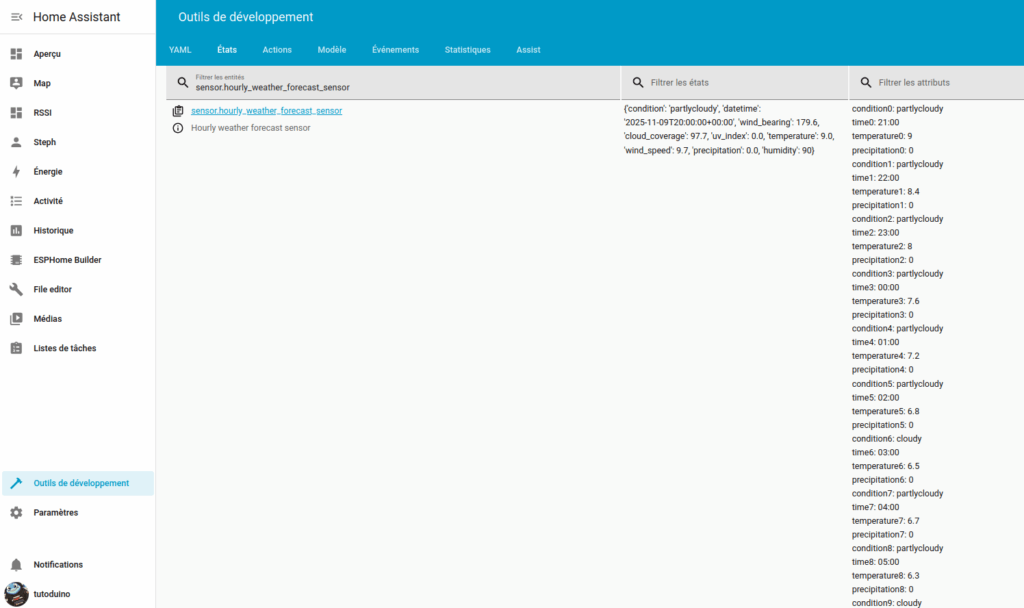
Note that the time attribute is displayed in local time using the HH:MM format, while datetime is returned in UTC. Local time conversion is performed by setting the second argument of timestamp_custom() to true.
Once the sensors are configured in Home Assistant, they must be declared in the ESPHome configuration:
Because time and condition are provided as text (for example, “11:00”, “sunny”), they should be defined as text_sensor entities. Temperature and precipition floating-point values should be defined as sensor entities:
text_sensor:
# hourly text sensors
- platform: homeassistant
entity_id: sensor.hourly_weather_forecast_sensor
attribute: time0
id: time_h0
- platform: homeassistant
entity_id: sensor.hourly_weather_forecast_sensor
attribute: condition0
id: condition_h0
- platform: homeassistant
entity_id: sensor.hourly_weather_forecast_sensor
attribute: time1
id: time_h1
- platform: homeassistant
entity_id: sensor.hourly_weather_forecast_sensor
attribute: condition1
id: condition_h1
- platform: homeassistant
entity_id: sensor.hourly_weather_forecast_sensor
attribute: time2
id: time_h2
- platform: homeassistant
entity_id: sensor.hourly_weather_forecast_sensor
attribute: condition2
id: condition_h2
- platform: homeassistant
entity_id: sensor.hourly_weather_forecast_sensor
attribute: time3
id: time_h3
- platform: homeassistant
entity_id: sensor.hourly_weather_forecast_sensor
attribute: condition3
id: condition_h3
- platform: homeassistant
entity_id: sensor.hourly_weather_forecast_sensor
attribute: time4
id: time_h4
- platform: homeassistant
entity_id: sensor.hourly_weather_forecast_sensor
attribute: condition4
id: condition_h4
- platform: homeassistant
entity_id: sensor.hourly_weather_forecast_sensor
attribute: time5
id: time_h5
- platform: homeassistant
entity_id: sensor.hourly_weather_forecast_sensor
attribute: condition5
id: condition_h5
- platform: homeassistant
entity_id: sensor.hourly_weather_forecast_sensor
attribute: time6
id: time_h6
- platform: homeassistant
entity_id: sensor.hourly_weather_forecast_sensor
attribute: condition6
id: condition_h6
- platform: homeassistant
entity_id: sensor.hourly_weather_forecast_sensor
attribute: time7
id: time_h7
- platform: homeassistant
entity_id: sensor.hourly_weather_forecast_sensor
attribute: condition7
id: condition_h7
- platform: homeassistant
entity_id: sensor.hourly_weather_forecast_sensor
attribute: time8
id: time_h8
- platform: homeassistant
entity_id: sensor.hourly_weather_forecast_sensor
attribute: condition8
id: condition_h8
- platform: homeassistant
entity_id: sensor.hourly_weather_forecast_sensor
attribute: time9
id: time_h9
- platform: homeassistant
entity_id: sensor.hourly_weather_forecast_sensor
attribute: condition9
id: condition_h9
- platform: homeassistant
entity_id: sensor.hourly_weather_forecast_sensor
attribute: time10
id: time_h10
- platform: homeassistant
entity_id: sensor.hourly_weather_forecast_sensor
attribute: condition10
id: condition_h10
- platform: homeassistant
entity_id: sensor.hourly_weather_forecast_sensor
attribute: time11
id: time_h11
- platform: homeassistant
entity_id: sensor.hourly_weather_forecast_sensor
attribute: condition11
id: condition_h11
sensor:
# Hourly sensors
- platform: homeassistant
entity_id: sensor.hourly_weather_forecast_sensor
attribute: temperature0
id: temperature_h0
- platform: homeassistant
entity_id: sensor.hourly_weather_forecast_sensor
attribute: precipitation0
id: precipitation_h0
- platform: homeassistant
entity_id: sensor.hourly_weather_forecast_sensor
attribute: temperature1
id: temperature_h1
- platform: homeassistant
entity_id: sensor.hourly_weather_forecast_sensor
attribute: precipitation1
id: precipitation_h1
- platform: homeassistant
entity_id: sensor.hourly_weather_forecast_sensor
attribute: temperature2
id: temperature_h2
- platform: homeassistant
entity_id: sensor.hourly_weather_forecast_sensor
attribute: precipitation2
id: precipitation_h2
- platform: homeassistant
entity_id: sensor.hourly_weather_forecast_sensor
attribute: temperature3
id: temperature_h3
- platform: homeassistant
entity_id: sensor.hourly_weather_forecast_sensor
attribute: precipitation3
id: precipitation_h3
- platform: homeassistant
entity_id: sensor.hourly_weather_forecast_sensor
attribute: temperature4
id: temperature_h4
- platform: homeassistant
entity_id: sensor.hourly_weather_forecast_sensor
attribute: precipitation4
id: precipitation_h4
- platform: homeassistant
entity_id: sensor.hourly_weather_forecast_sensor
attribute: temperature5
id: temperature_h5
- platform: homeassistant
entity_id: sensor.hourly_weather_forecast_sensor
attribute: precipitation5
id: precipitation_h5
- platform: homeassistant
entity_id: sensor.hourly_weather_forecast_sensor
attribute: temperature6
id: temperature_h6
- platform: homeassistant
entity_id: sensor.hourly_weather_forecast_sensor
attribute: precipitation6
id: precipitation_h6
- platform: homeassistant
entity_id: sensor.hourly_weather_forecast_sensor
attribute: temperature7
id: temperature_h7
- platform: homeassistant
entity_id: sensor.hourly_weather_forecast_sensor
attribute: precipitation7
id: precipitation_h7
- platform: homeassistant
entity_id: sensor.hourly_weather_forecast_sensor
attribute: temperature8
id: temperature_h8
- platform: homeassistant
entity_id: sensor.hourly_weather_forecast_sensor
attribute: precipitation8
id: precipitation_h8
- platform: homeassistant
entity_id: sensor.hourly_weather_forecast_sensor
attribute: temperature9
id: temperature_h9
- platform: homeassistant
entity_id: sensor.hourly_weather_forecast_sensor
attribute: precipitation9
id: precipitation_h9
- platform: homeassistant
entity_id: sensor.hourly_weather_forecast_sensor
attribute: temperature10
id: temperature_h10
- platform: homeassistant
entity_id: sensor.hourly_weather_forecast_sensor
attribute: precipitation10
id: precipitation_h10
- platform: homeassistant
entity_id: sensor.hourly_weather_forecast_sensor
attribute: temperature11
id: temperature_h11
- platform: homeassistant
entity_id: sensor.hourly_weather_forecast_sensor
attribute: precipitation11
id: precipitation_h11
Display battery charge
To retrieve the reTerminal’s battery level, you must enable battery voltage measurement by configuring GPIO21 (VBAT ENABLE) during reTerminal boot. The reading is then taken from GPIO1 (VBAT ADC), which is internally connected to the battery via a measurement circuit.
esphome:
name: reterminal
friendly_name: reTerminal
on_boot:
priority: 600
then:
- output.turn_on: bsp_battery_enable
- delay: 500ms
captive_portal:
output:
- platform: gpio
pin: GPIO21
id: bsp_battery_enable
sensor:
# ADC for battery voltage measurement
- platform: adc
pin: GPIO1
name: "Battery Voltage"
id: battery_voltage
update_interval: 600s
attenuation: 12db
filters:
- multiply: 2.0 # Voltage divider compensationBy reading the analog value on GPIO1, we retrieve the internal battery voltage. The technical documentation of the reTerminal E1001 shows that the voltage is measured using a voltage divider, so a filter must be applied to compensate for the halving of the voltage caused by this divider, which consists of two 10kΩ resistors.


A -12 dB attenuation setting allows you to measure voltages above 1.1 V on GPIO1. By default, the attenuation is 0 dB, allowing you to measure voltages between 0 and 1.1 V. A -12 dB attenuation setting allows you to measure voltages between 0 and 2.5 V.
The voltage across the internal battery indicates its charge level. A lithium battery is considered discharged if its voltage is below 3.3 V. A battery is fully charged when its voltage is above 4.0 V.

Display Wifi signal strength
Displaying the reTerminal’s Wi-Fi signal strength can be useful though optional.
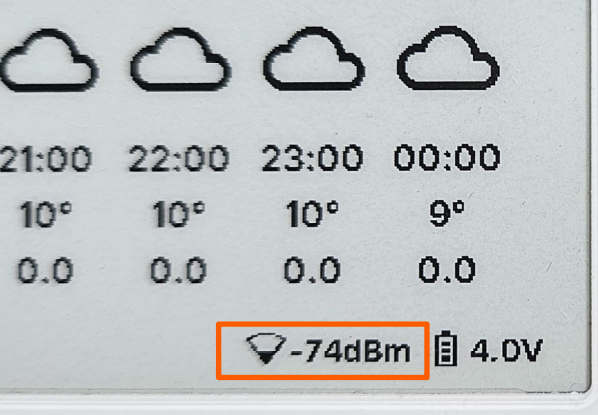
This information is provided by ESPHome. To get it, you only need to declare wifi_signal sensor in ESPHome configuration:
sensor:
- platform: wifi_signal
name: "Signal WiFi ReTerminal"
id: wifi_signal_strength
update_interval: never Since Wi‑Fi isn’t available at boot time, I decided to update its measurement when the reTerminal receives the daily weather forecast. At that point, the Wi‑Fi connection is already established, and it’s also when I start refreshing the display.
- platform: homeassistant
id: temperature_d0
entity_id: sensor.daily_weather_forecast_sensor
attribute: temperature0
on_value:
then:
# Update the Wifi signal measurement and refresh the e-paper display whenever this sensor updates
- component.update: wifi_signal_strength
- component.update: epaper_display
Displaying icons
I chose to display the icons using the materialdesignicons-webfont.ttf font instead of images. You’ll need to download this font and place it in the ESPHome fonts directory using a File Editor add-on, for example. To choose your own icons, you can use the pictogrammers.com website and note the reference number of the desired icon.

Next, you need to declare the glyphs corresponding to the icons in the font. Here, for example, on a font size of 20, we want to use the icons representing a battery, a water droplet, a thermometer, and a clock.
- file: "fonts/materialdesignicons-webfont.ttf"
id: icon_font_20
size: 20
glyphs:
- "\U000F12A3" # battery
- "\U000F058C" # water
- "\U000F050F" # thermometer
- "\U000F1442" # clockThen you can display the icon from its code like this:
it.printf(0, 0+85, id(icon_font_20), "\U000F050F"); // thermometerDeep sleep
The reTerminal E1001 is configured to remain in deep sleep for 30 minutes. After these 30 minutes, it wakes up for 30 seconds to retrieve weather information and update its screen. It then returns to deep sleep for another 30 minutes.
This deep sleep mode is configured as follows in the ESPHome YAML configuration file:
# Deep sleep configuration to save power
deep_sleep:
id: deep_sleep_1 # ID for deep sleep component
run_duration: 30s # Time to stay awake after wake-up
sleep_duration: 30min # Time to sleep between wake-ups
wakeup_pin: GPIO3 # GPIO pin to wake up device
wakeup_pin_mode: INVERT_WAKEUP # Inverted wake-up logicDisplay refresh
When reTerminal wakes from deep sleep, it behaves the same way as during startup. Therefore, a precise sequence of events must be maintained. The reTerminal screen should only be refreshed once the data from the internal sensor and Home Assistant has been retrieved (Wi-Fi takes time to activate, and therefore Home Assistant data is not immediately available at boot).
Update the battery voltage measurement and the internal temperature and humidity sensor measurement at boot time:
esphome:
name: reterminal-e1001
friendly_name: reTerminal-e1001
on_boot:
priority: 600
then:
# Turn on the GPIO output that powers the battery measurement circuit
- output.turn_on: bsp_battery_enable
# Wait a short delay to allow power stabilization
- delay: 500ms
# Manually update battery sensors (voltage and percentage)
- component.update: battery_voltage
# Manually read the internal temperature/humidity sensor
- component.update: sht4x_component Disable automatic updates (update_interval: never) for the ST4X internal sensor:
# Internal SHT4x temperature/humidity sensor
- platform: sht4x # Sensor platform
id: sht4x_component # ID for the component
temperature: # Temperature sensor
name: "Temperature" # Sensor name
id: sht4x_temperature # ID for temperature sensor
humidity: # Humidity sensor
name: "Humidity" # Sensor name
id: sht4x_humidity # ID for humidity sensor
address: 0x44 # I2C address
update_interval: never # Disable automatic updates (manual read only)Disable automatic screen refresh (update_interval: never):
display:
- platform: waveshare_epaper
id: epaper_display
model: 7.50inv2
cs_pin: GPIO10
dc_pin: GPIO11
reset_pin:
number: GPIO12
inverted: false
busy_pin:
number: GPIO13
inverted: true
update_interval: neverAnd finally, refresh the screen once Home Assistant data is received (for example on temperature0 update):
# Daily sensors
- platform: homeassistant
id: temperature_d0
entity_id: sensor.daily_weather_forecast_sensor
attribute: temperature0
on_value:
then:
# Refresh the e-paper display whenever this sensor updates
- component.update: epaper_display Conclusion
Thanks to the reTerminal E1001 and its integration with Home Assistant, I finally have the perfect weather station to meet my needs. The ESPHome framework requires a short learning curve to grasp its principles, but once you’ve mastered them, it proves remarkably powerful and flexible.
The complete Home Assistant and ESPHome configuration used in this tutorial is available on my GitHub.
I hope you found this tutorial helpful. Feel free to share your feedback by clicking on the stars below or leaving a comment.

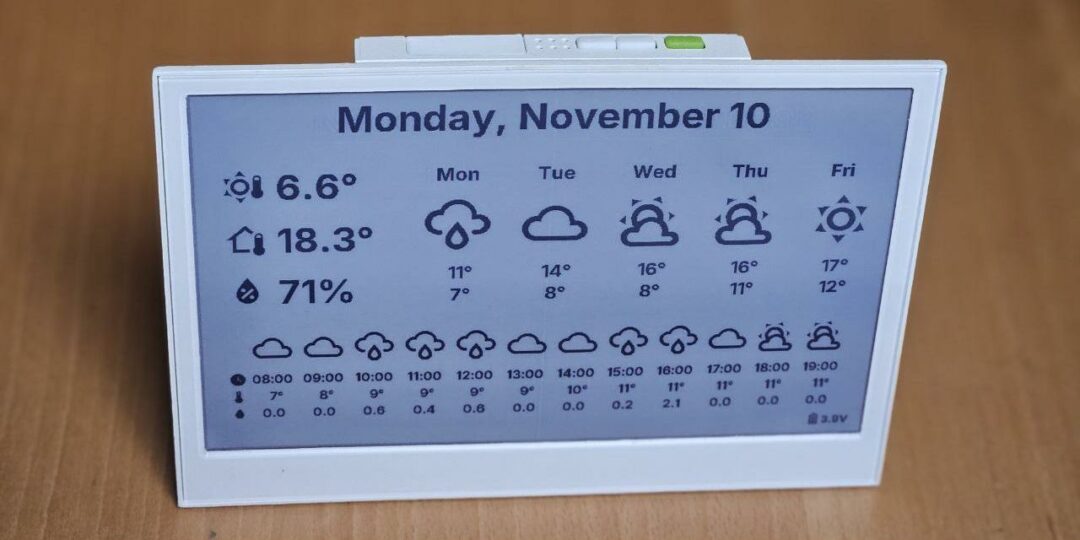
[…] на экране электронной бумаги reTerminal E1001, следуя инструкциям, предоставленным Tutoduino9 и используя файлы конфигурации из соответствующего […]
[…] You can have a look to my other ESPHome tutorials Integrate a reTerminal E1002 into Home Assistant with ESPHome and Home Assistant: Displaying weather data on a reTerminal E1001 with ESPHome. […]
Loving your blog, as I have ordered an E1001 and an E1002. While I’m waiting for it to arrive, I was trying to get the weather forecast prebuilt.
But I’m trying and failing to get your code working. For daily_weather_forecast_sensor I pasted it into my template.yaml, but it doesn’t seem to want to work. I’m on Home Assistant 2025.11.2. Some of the code is deprecated, such as:
– platform: time_pattern (platform should be trigger)
– service: weather.get_forecasts (service should be action)
Even with these changes, getting this in the log:
[33m2025-11-18 19:51:03.805 WARNING (MainThread) [homeassistant.helpers.template] Template variable warning: None has no element 0 when rendering ‘{{ state_attr(‘sensor.weather_forecast’,’daily_forecast’)[0] }}'[0m
[31m2025-11-18 19:53:51.775 ERROR (MainThread) [homeassistant.helpers.template] Template variable error: None has no element 1 when rendering ‘{{ as_timestamp(state_attr(‘sensor.weather_forecast’,’daily_forecast’)[1].datetime) | timestamp_custom(‘%a’, True) }}'[0m
Are you on an older version of Home Assistant?
Thanks for your kind message.
I am also on HA 2025.11.2, using HA OS on a Raspberry Pi 4.
I did not use template.yaml, instead all configuration is located in my HA configuration.yaml file…
Can you try putting the code in the main configuration.yaml file ?